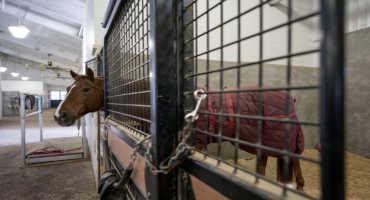Sarah White-Springer, Ph.D., an associate professor in the Department of Animal Science in Texas A&M’s College of Agriculture and Life Sciences, explains what goes into the training and care of racehorses.
“We must speak of racehorses as athletes. They’re the most elite we can find, so we must treat them as such,” White-Springer said. “The best preventive measures you can take are ensuring they are fed and managed right, and making sure the exercise isn’t too intense, so horses can adapt incrementally.”
Starting young
Most performance equine athletes are exercised five times a week. However, racehorses typically receive an additional day of exercise on a track, White-Springer said.
She said it takes roughly a year and a half to train a horse before its first race.
“They are broke to ride as a yearling,” White-Springer said. “In the fall, they are ridden for the first time, starting slow then progressively advancing to sprints.”
While racehorses begin racing within the first two years of their lives, the “prime” racing age depends on the horse. Performance can depend on their brain. Some horses prefer to run in the front of the pack and to compete with their fellow horses.
“It’s not just about how fast they can run; some horses’ brains don’t mature as fast as others,” White-Springer said. “Horses will reach their peak at different ages.”
Proper nutrition for racehorses
Feeding and caring for a racehorse is no minor task, with a large emphasis on nutritional value and avoiding injury.
“Racing is what we consider the highest intensity exercise for horses,” White-Springer said. “Those horses need a lot more calories than others.”
Racehorses burn lots of calories during races and other exercises, so they rely heavily on calories as a source of energy, White-Springer said. She also emphasizes the role that protein, fat, calcium and antioxidants play in proper nutrition for racehorses. These nutrients prevent deficiencies and prioritize skeletal and muscle health.
While it is hard to precisely pinpoint how much more of these nutrients racehorses need due to a lack of research funding, White-Springer said it is known that the need increases with the workload. Since racing is high-intensity, the necessity will be higher.
Avoiding injuries
The most severe injury, catastrophic bone failure, is not as common as one might think. While these injuries can happen, White-Springer said bone failures are less likely to occur.
“The most common injuries we see in racehorses are soft tissue injuries which often lead to lameness,” she said.
Lameness, when a horse changes their gait to accommodate a hurting limb, creates problems for racehorses due to how important their pace is for the sport. If a horse is injured to the point of displaying an altered gait, that injury needs time to heal before the horse is put under additional strain to prevent further damage.

She said footing plays a significant role in injuries. Horses must alter their gate the ground is muddy to accommodate the feeling of the ground since they are at risk of slipping.
“Because racehorses are moving at such a high intensity, every little thing is magnified,” White-Springer said.
Rest is also essential to give the equine athlete’s body time to adapt. Preventing severe injuries, such as catastrophic bone failures, is dependent on that rest. White-Springer said she believes large injuries develop from smaller injuries or abnormalities that can occasionally go unnoticed in racehorses.
“If you can be intuitive with your horse and pick up on those small abnormalities, you can get them taken care of early and avoid the larger problems later on,” she said.
Getting racehorses to the homestretch
Racehorses must pass a veterinary inspection to ensure temperature and respiratory rate are not elevated prior to races and that there is no drug use involved with the horses. Beyond the vet’s checklist for racing, White-Springer said racehorses are best cared for through meeting nutritional requirements, incremental training and small acts of recovery.
White-Springer emphasized the importance of foraging in the diet of racehorses and having proper periods of rest built into their exercise training programs. Recovery and proper training is important for equine athletes, just as it is for human athletes.
Source : tamu.edu